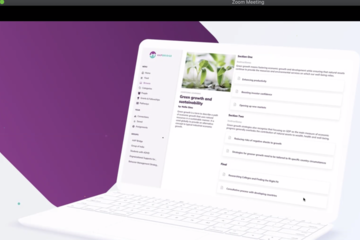Browse
Navigating Context
Posted on: #iteachmsu


Posted by
almost 2 years ago
Full blood counts
Department of Haematology
Notes
Full blood counts are performed on automated equipment and provide haemoglobin concentration, red cell indices, white cell count (with a differential count) and platelet count.
The presence of abnormal white cell and red cell morphology is flagged by the analysers.
Blood films may be inspected to confirm and interpret abnormalities identified by the cell counter, or to look for certain specific haematological abnormalities.
Grossly abnormal FBC results and abnormal blood films will be phoned through to the requestor.
There is no need to request a blood film to obtain a differential white count. It is, however, important that clinical details are provided to allow the laboratory to decide whether a blood film, in addition to the automated analysis, is required.
Under some circumstances a differential is not routinely performed, e.g. pre-op, post-op, antenatal and postnatal requests.
Full Blood Counts are performed at CGH and GRH
See also: Reticulocyte Count
The FBC comprises the following tests
Standard
Haemoglobin (Hb)
White Blood Count (WBC)
Platelet Count (Plt)
Red Cell Count (RBC)
Haematocrit (HCT)
Mean Cell Volume - Red cell (MCV)
Mean Cell Haemoglobin (MCH)
Differential White Cell Count (where applicable)
Neutrophils
Lymphocytes
Monocytes
Eosinophils
Basophils
And if appropriate
Blood Film
Sample Requirements
2ml or 4ml EDTA sample or a Paediatric 1ml EDTA sample.
EDTA with cap
1ml Paediatric EDTA
Sample Storage and Retention
Pre analysis storage: do not store, send to laboratory within 4 hours.
Sample retention by lab: EDTA samples are retained for a minimum of 48 hours at 2-10°C
Transport of samples may affect sample viability, i.e. FBC results will degenerate if exposed to high temperatures, such as prolonged transportation in a hot car in summer.
This test can be added on to a previous request as long as there is sufficient sample remaining and the sample is less than 24 hours old.
Turnaround Times
Clinical emergency: 30 mins
Other urgent sample: 60 mins
Routine: within 2 hours
Reference Ranges
If references ranges are required for paediatric patients please contact the laboratory for these.
Parameter Patient Reference Range Units Haemoglobin Adult Male 130 - 180 g/L Adult Female 115 - 165 g/L Red Cell Count Adult Male 4.50 - 6.50 x10^12/L Adult Female 3.80 - 5.80 x10^12/L Haematocrit Adult Male 0.40 - 0.54 L/L Adult Female 0.37 - 0.47 L/L Mean Cell Volume Adult 80 - 100 fL Mean Cell Haemoglobin Adult 27 - 32 pg White Cell Count Adult 3.6 - 11.0 x10^9/L Neutrophils Adult 1.8 - 7.5 x10^9/L Lymphocytes Adult 1.0 - 4.0 x10^9/L Monocytes Adult 0.2 - 0.8 x10^9/L Eosinophils Adult 0.1 - 0.4 x10^9/L Basophils Adult 0.02 - 0.10 x10^9/L Platelet Count Adult 140 - 400 x10^9/L
Department of Haematology
Notes
Full blood counts are performed on automated equipment and provide haemoglobin concentration, red cell indices, white cell count (with a differential count) and platelet count.
The presence of abnormal white cell and red cell morphology is flagged by the analysers.
Blood films may be inspected to confirm and interpret abnormalities identified by the cell counter, or to look for certain specific haematological abnormalities.
Grossly abnormal FBC results and abnormal blood films will be phoned through to the requestor.
There is no need to request a blood film to obtain a differential white count. It is, however, important that clinical details are provided to allow the laboratory to decide whether a blood film, in addition to the automated analysis, is required.
Under some circumstances a differential is not routinely performed, e.g. pre-op, post-op, antenatal and postnatal requests.
Full Blood Counts are performed at CGH and GRH
See also: Reticulocyte Count
The FBC comprises the following tests
Standard
Haemoglobin (Hb)
White Blood Count (WBC)
Platelet Count (Plt)
Red Cell Count (RBC)
Haematocrit (HCT)
Mean Cell Volume - Red cell (MCV)
Mean Cell Haemoglobin (MCH)
Differential White Cell Count (where applicable)
Neutrophils
Lymphocytes
Monocytes
Eosinophils
Basophils
And if appropriate
Blood Film
Sample Requirements
2ml or 4ml EDTA sample or a Paediatric 1ml EDTA sample.
EDTA with cap
1ml Paediatric EDTA
Sample Storage and Retention
Pre analysis storage: do not store, send to laboratory within 4 hours.
Sample retention by lab: EDTA samples are retained for a minimum of 48 hours at 2-10°C
Transport of samples may affect sample viability, i.e. FBC results will degenerate if exposed to high temperatures, such as prolonged transportation in a hot car in summer.
This test can be added on to a previous request as long as there is sufficient sample remaining and the sample is less than 24 hours old.
Turnaround Times
Clinical emergency: 30 mins
Other urgent sample: 60 mins
Routine: within 2 hours
Reference Ranges
If references ranges are required for paediatric patients please contact the laboratory for these.
Parameter Patient Reference Range Units Haemoglobin Adult Male 130 - 180 g/L Adult Female 115 - 165 g/L Red Cell Count Adult Male 4.50 - 6.50 x10^12/L Adult Female 3.80 - 5.80 x10^12/L Haematocrit Adult Male 0.40 - 0.54 L/L Adult Female 0.37 - 0.47 L/L Mean Cell Volume Adult 80 - 100 fL Mean Cell Haemoglobin Adult 27 - 32 pg White Cell Count Adult 3.6 - 11.0 x10^9/L Neutrophils Adult 1.8 - 7.5 x10^9/L Lymphocytes Adult 1.0 - 4.0 x10^9/L Monocytes Adult 0.2 - 0.8 x10^9/L Eosinophils Adult 0.1 - 0.4 x10^9/L Basophils Adult 0.02 - 0.10 x10^9/L Platelet Count Adult 140 - 400 x10^9/L
Navigating Context
Posted on: #iteachmsu

Navigating Context
Digital Collaborative Learning for the 21st Century 2.0 (Learning Community for AY2023-2024)
Posted by:
Chathuri Super admin..

Posted on 1: #iteachmsu

Digital Collaborative Learning for the 21st Century 2.0 (Learning Community for AY2023-2024)
NAVIGATING CONTEXT
Posted by:
Chathuri Super admin..

Posted on: #iteachmsu

Navigating Context
This supercomputer will perform 1,000,000,000,000,000,000 operations per second
Posted by:
Chathuri Super admin..

Posted on 1: #iteachmsu

This supercomputer will perform 1,000,000,000,000,000,000 operations per second
NAVIGATING CONTEXT
Posted by:
Chathuri Super admin..

Posted on: #iteachmsu

Navigating Context
PRIMER: What is Attention Deficit Hyperactivity Disorder? - ADDED
Authored by:
Super admin - R

Posted on 1: #iteachmsu

PRIMER: What is Attention Deficit Hyperactivity Disorder? - ADDED
NAVIGATING CONTEXT
Authored by:
Super admin - R

Posted on: #iteachmsu
![post image]()
NAVIGATING CONTEXT
Blog
https://www.wix.com/html5en/hiker-blog?experiment_id=blog%5Ee%5E301311168892%5E1t1&gclid=EAIaIQobChMIgsaHr6yc3gIVTA4rCh1khQUPEAAYASAAEgJx6PD_BwE&utm_campaign=1493445982%5E64170736230&utm_medium=cpc&utm_source=google
Posted by:
Chathuri Super admin..
Posted on: #iteachmsu

Navigating Context
A human resources management system or human resources information system or human capital managemen
Posted by:
Chathuri Super admin..

Posted on 1: #iteachmsu

A human resources management system or human resources information system or human capital managemen
NAVIGATING CONTEXT
Posted by:
Chathuri Super admin..

Posted on: #iteachmsu

Navigating Context
PRIMER: What is Attention Deficit Hyperactivity Disorder? - ADDED
Authored by:
Henry 935
Posted on 1: #iteachmsu

PRIMER: What is Attention Deficit Hyperactivity Disorder? - ADDED
NAVIGATING CONTEXT
Authored by:
Henry 935
Posted on: #iteachmsu



Posted by
about 2 years ago

Culture of Collaboration & Interprofessional Teaming
Descriptions :
This program is an online continuous course with no specific start or end date.
Creating a Culture of Collaboration and Interprofessional Teaming is an online self-paced course offering. This offering is made possible through the support of Venturit's internal WIzdn team.
Descriptions :
This program is an online continuous course with no specific start or end date.
Creating a Culture of Collaboration and Interprofessional Teaming is an online self-paced course offering. This offering is made possible through the support of Venturit's internal WIzdn team.
Navigating Context
